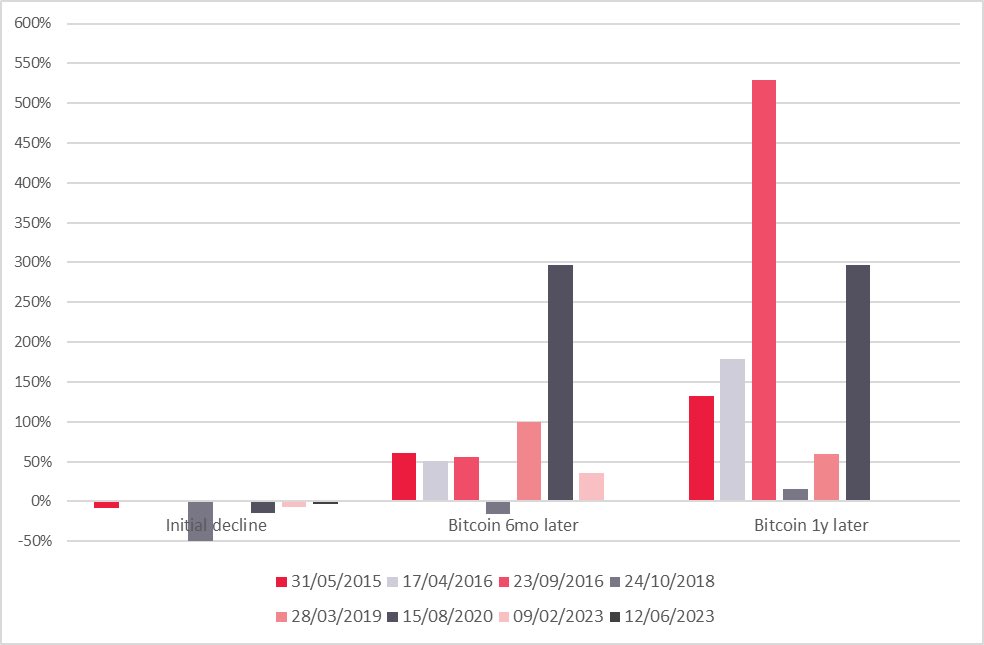Jeffrey Reyes • 2:40 AM August 27, 2023
Digital Nugget: Is low volatility a buy signal?
Digital Nugget: Is low volatility a buy signal?
Extremes of low volatility in the crypto market have historically been followed by strong upside performance. Despite Bitcoin experiencing its largest daily move since mid-March last week, volatility remains low
Historic patterns
Bitcoin’s long run average volatility is around 60 percent, and it has been in the 40–80 percent range three quarters of the time. After six out of the seven prior instances of Bitcoin’s 3-month volatility falling below 40 percent, strong performance followed.
The chart below shows the price performance of Bitcoin after volatility dropped to the bottom 15 percent of the historic range.
Bitcoin returns following a drop in 3-month volatility below 40 percent

Six months after the volatility fell below 40 percent, Bitcoin was on average 83 percent higher. One year later, it was on average 202 percent higher.
There was only one instance when the market fell sharply after a volatility drop, initially declining 50 percent. Despite a consequent recovery, it still showed a 16 percent loss after six months. Even in that instance, Bitcoin generated a small positive return over one year (+15 percent).
In all other instances, low volatility periods were followed by strong returns.
Why does this happen?
Bull markets are often preceded by low volatility periods. This is in part due to the pattern of falling volatility as bear markets wear on and seller exhaustion sets in while the market lacks catalysts to the upside.
Although the catalyst that moves the market after a low volatility period may be positive or negative, the likelihood of a positive catalyst is higher after the market digested a lot of bad news during a bear market.
Current catalysts
The unusual price behaviour during the 2022 bear market demonstrated that there is strong medium- to-long term conviction in the asset class, as there was a lack of follow-on selling after market shocks (Terra, Celsius, FTX). This, coupled with most major financial institutions continuing to build crypto capabilities, suggests that there are structurally more buyers than sellers for crypto.
After last year’s shock events, the newsflow has remained overwhelmingly negative this year, with hostile US regulatory actions, repeated crises in the stablecoin sector, problems with access to bank accounts for crypto projects and with settlement systems that provided fiat-to-crypto onramps.
The market has digested a lot of bad news this year, and it has been offered little in the way of good news. None of the use cases demonstrated breakthrough successes, and on-chain activity has remained muted overall. It is a further demonstration of the strong structural demand that in the year to date, the crypto market is up 40 percent (and Bitcoin almost 60 percent) in the face of mostly negative newsflow.
Meanwhile, the gains from the recent positive catalysts of BlackRock’s ETF filing and the favourable Ripple ruling have mostly been erased as the market debates the likelihood of a spot ETF approval and the SEC has moved to appeal the ruling.
As a lot of bad news has been digested by the market and the potential positive catalysts are not priced, the likelihood is strongly tilted towards the emergence of upside catalysts.
Risks
US regulatory moves have led to leading exchanges and market-makers reducing their presence in the US market. As the US has been the most liquid timezone for crypto since 2018, this led to an overall reduction in liquidity for crypto, increasing the probability of sudden sharp market moves in either direction.
This also means upside moves on catalysts can happen very quickly. Indeed, this year’s positive performance was generated in just a few days during January, March and June.
Therefore, positioning for likely positive catalysts with a 6–12 month investment horizon appears to be a better risk/reward investment than waiting for the uptrend on these catalysts to be confirmed.
Summary
A low volatility period such as the one we are experiencing this year has historically been a harbinger of strong returns. With 2022’s “reluctant bear market” behind us and a lot of bad news so far this year, the catalysts over the next 6–12 months are most likely to be to the upside. With reduced liquidity, the up moves are likely to occur very quickly.
